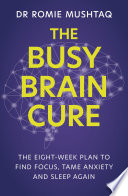

The first key idea in 'The Busy Brain Cure' is the concept of the 'busy brain' itself. The author explores how modern society bombards individuals with constant stimuli, leading to an overstimulated mind. This busy brain manifests in various forms, such as anxiety, distraction, and a perpetual sense of urgency. The author argues that in order to overcome these challenges, one must first understand the underlying mechanisms of the busy brain. This involves recognizing the signs of mental overload, such as difficulty concentrating, racing thoughts, and an inability to relax. By becoming aware of these symptoms, individuals can begin to take steps toward regaining control over their mental state. The book emphasizes the importance of mindfulness and self-awareness as foundational tools for identifying when the brain is overwhelmed. The author provides practical exercises to help readers tune into their mental state, encouraging them to regularly check in with themselves throughout the day. Through this understanding, readers can learn to differentiate between productive busyness and counterproductive distractions.
Continue readingThe second key idea revolves around the science of focus and how it can be harnessed to combat the busy brain. The author delves into cognitive psychology and neuroscience to explain how focus works and why it is essential for productivity. The book highlights the concept of attention as a limited resource, which can be easily depleted by multitasking and constant interruptions. The author presents research findings that demonstrate how our brains are not wired for multitasking, and instead, we perform better when we concentrate on one task at a time. Practical strategies for improving focus are provided, such as the Pomodoro Technique, which encourages readers to work in short bursts followed by breaks. The author also discusses the importance of creating an optimal work environment, free from distractions, to enhance concentration. By implementing these focus-enhancing techniques, readers can train their brains to become more efficient and effective in their work.
Continue readingIn the third key idea, the author examines the dual role of technology in contributing to and alleviating the busy brain phenomenon. While technology is often blamed for increasing distractions, the author argues that it can also be a powerful tool for improving productivity when used mindfully. The book discusses the impact of social media, notifications, and constant connectivity on mental well-being. The author urges readers to take control of their technology use by setting boundaries, such as limiting screen time and turning off non-essential notifications. Additionally, the book introduces various apps and tools designed to enhance focus and organization, such as task management software and meditation apps. By finding a balance between leveraging technology for productivity and minimizing its disruptive effects, readers can create a healthier relationship with their devices.
Continue readingThe fourth key idea emphasizes the importance of mindfulness in achieving mental clarity. The author advocates for incorporating mindfulness practices into daily routines as a means to combat the busy brain. Mindfulness meditation, deep breathing exercises, and mindful walking are presented as effective techniques for grounding oneself and reducing mental clutter. The author explains how these practices can help individuals develop a greater awareness of their thoughts and emotions, allowing them to respond to stressors with clarity rather than reactivity. By cultivating a regular mindfulness practice, readers can enhance their ability to focus, improve emotional regulation, and foster a sense of calm amidst the chaos of daily life. The book provides guided meditations and mindfulness exercises that readers can easily integrate into their schedules.
Continue readingThe fifth key idea focuses on practical time management strategies that can help alleviate the busy brain. The author outlines various techniques for prioritizing tasks, setting realistic goals, and managing time effectively. One notable approach discussed is the Eisenhower Matrix, which helps individuals categorize tasks based on urgency and importance. The book encourages readers to adopt a proactive mindset when it comes to time management, suggesting that they regularly review their schedules and adjust as necessary. Additionally, the author emphasizes the importance of setting boundaries, both in personal and professional contexts, to protect time for focused work. By implementing these time management strategies, readers can reduce feelings of overwhelm and create a more structured approach to their daily activities.
Continue readingThe sixth key idea addresses the importance of building resilience in the face of a busy brain. The author explains that resilience is the ability to bounce back from setbacks and adapt to challenges. The book offers insights into developing a resilient mindset through practices such as positive self-talk, reframing negative thoughts, and embracing failure as a learning opportunity. The author also discusses the role of social support in fostering resilience, encouraging readers to cultivate strong relationships and seek help when needed. By strengthening their resilience, individuals can better navigate the ups and downs of life without becoming overwhelmed by stress and anxiety.
Continue readingThe final key idea centers on creating a sustainable lifestyle that supports mental well-being. The author argues that true productivity is not just about getting more done, but about creating a balanced life that prioritizes health and happiness. This involves making conscious choices about nutrition, exercise, and sleep, as these factors significantly impact mental clarity and overall well-being. The book encourages readers to establish healthy routines that promote physical and mental health, such as regular exercise, balanced nutrition, and sufficient sleep. By adopting a holistic approach to well-being, readers can cultivate a sustainable lifestyle that supports their productivity and helps them manage their busy brains effectively.
Continue reading